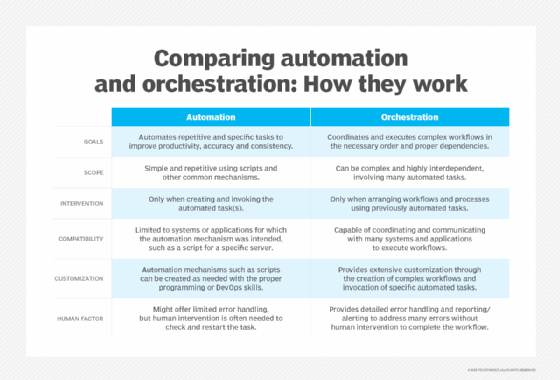What is workflow orchestration?
Workflow orchestration is the process of coordinating and automating tasks across different systems to ensure they run within a defined workflow.
Workflow orchestration software manages multiple automated tasks based on defined schedules, dependencies and other factors. By orchestrating automated functions, organizations and IT teams reduce the need for manual effort, while also increasing operational efficiency.
Workflow orchestration tools are proficient at managing automated, repeatable and interdependent tasks. This process is also helpful for IT, DevOps and data teams to manage complex processes with multiple dependencies.
How does workflow orchestration work?
Workflow orchestration software doesn't necessarily perform automated tasks; it manages and coordinates them. The idea is to define and orchestrate the what, when and how behind different automated tasks to define a workflow. As such, workflow orchestration tools focus on coordinating and managing different automated tasks across various systems and applications.
The process begins by defining the workflow itself. Each step is mapped out, determining the required integrations and dependencies to handle the process from beginning to end.
The organization then selects an orchestration platform that best matches its business needs. Workflow orchestration software defines workflows by determining different sequences, dependencies, triggers and conditions between each automated task. These tools also typically include an interface for monitoring each task and overall workflow executions in real time. Workflow orchestration tools can also determine that data is properly shared between tasks.
This process also clarifies how components in a defined workflow interact and affect one another.
Benefits of workflow orchestration
Workflow orchestration offers organizations the following benefits:
- Improved communication. Workflows commonly cross different systems that require increased communication between teams.
- Cost savings. Orchestrating increases the efficiency between tasks in a workflow, decreasing the cost of previously needed manual operations.
- Increased efficiency. Automating repetitive tasks and orchestrating their execution increases the organization's efficiency, as it lightens human workers' workloads, enabling them to complete other work.
- Error reduction. Orchestrating repetitive tasks can help reduce human errors.
- Enhanced integrations. Orchestration platforms can integrate with several other popular automation tools.
- Simplified scaling. Workflow orchestration can scale across different systems, including cloud and hybrid cloud environments.
Best practices for workflow orchestration
Organizations that are considering workflow orchestration should evaluate the following best practices to ensure successful implementation:
- Understand and define current workflows. Organizations should map out existing automation processes and workflows before implementing workflow orchestration so they can better understand key needs and dependencies between tasks.
- Choose the right orchestration and automation tools. Understanding an organization's process bottlenecks at the beginning of the process enables IT to determine if they are using the right automation tools for each task. Likewise, the orchestration tool chosen should be able to integrate properly with those automation tools.
- Start with smaller, manageable processes. Beginning with simple, well-understood processes helps minimize risks, while building more confidence and experience before scaling up to more complex processes.
- Involve stakeholders. Many processes involve different departments, including IT teams, users and related entities, and keeping them informed from the start can help align the orchestration process with business goals.
- See improvements to processes as continuous improvement. Orchestration should be viewed as a continually changing process that the organization monitors for potential issues or opportunities for optimization.
- Ensure security. Orchestration tools and workflows should follow internal and external policies and regulations for data privacy, access control and auditing to ensure security.
Tools for workflow orchestration
An organization should choose an orchestration platform based on the area of orchestration needed, integration with other tools, ease of use, task size and complexity.
The following is a sampling of available workflow orchestration tools:
- Apache Airflow. Apache Airflow is a workflow orchestration platform that schedules and monitors workflows. It is commonly used to orchestrate data engineering tasks.
- Camunda. Camunda can orchestrate automated system tasks, while also considering human-based processes. It is used to orchestrate business processes.
- HashiCorp Terraform. Terraform is an infrastructure-as-code tool that provisions and manages cloud infrastructure and can orchestrate infrastructure-related workflows.
- Kubernetes. Kubernetes is a container orchestration tool for managing containerized applications. It can orchestrate application workflows for sequencing automatic tasks by scheduling containers across defined clusters.
- Red Hat Ansible. Ansible is an open source IT automation tool that can orchestrate infrastructure provisioning, configuration management and app deployment workflows.
Workflow orchestration use cases
Workflow orchestration has many practical use cases across different industries and organizations.
Some organizations, for example, use workflow orchestration tools to streamline their software development processes. They can help orchestrate and sequence automated tasks, speeding up the process.
Other organizations might also use workflow orchestration software for managing data pipelines, ensuring that data flows smoothly between automated tasks and processes. This improves the efficacy and management of massive data sets.
Others might use it to orchestrate internet of things (IoT) systems. For example, orchestration can help ensure consistent interactions and data flow between IoT devices. In healthcare, orchestration can help process patient data and manage claims. And, in finance sectors, it can help create consistent workflows between invoices and approvals.
Workflow orchestration vs. workflow automation
While workflow orchestration and workflow automation are similar concepts, they differ. The most significant differences are scale and how automated components relate.
Workflow automation uses automation to perform individual tasks in a workflow without human intervention. These tasks are performed independently within a defined set of business rules.

Meanwhile, workflow orchestration focuses on managing the sequence and interaction of multiple automated tasks into a single definable workflow. Multiple automated tasks across different systems and environments are coordinated to ensure they are consistently executed at the correct time.
Workflow orchestration and workflow automation are two distinct but closely related concepts. Learn more about the key differences between orchestration and automation in IT.







